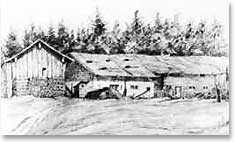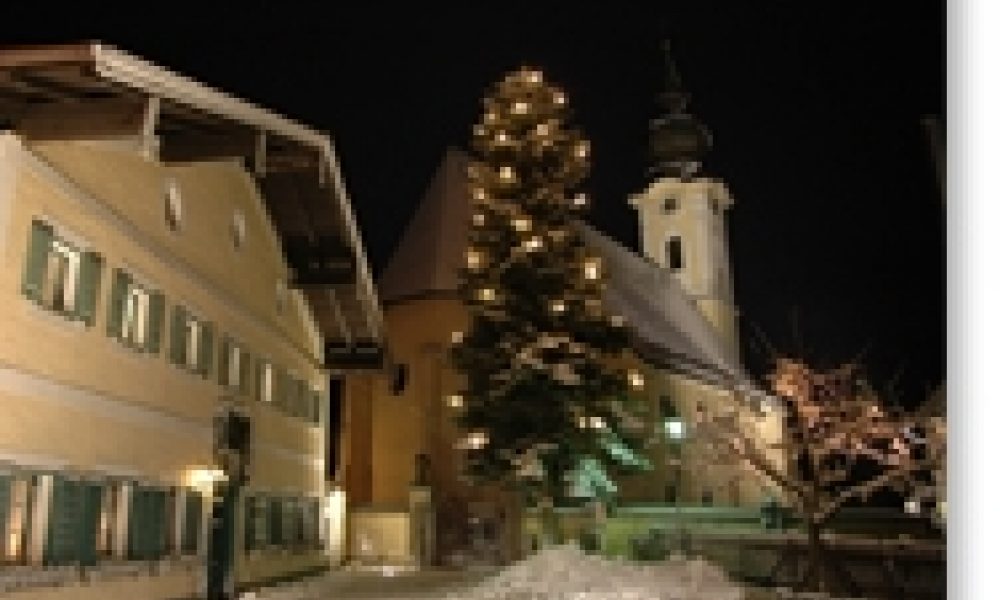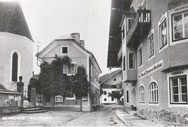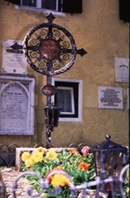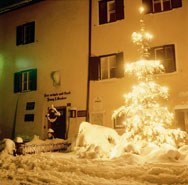Franz Xaver Gruber
Hochburg - childhood and education
Franz Xaver Gruber was born on November 25, 1787 at Unterweizburg 9 in the village of Hochburg in the Inn River region of Upper Austria. His given name was recorded in the baptismal record as "Conrad Xavier," but this was later changed to "Franz Xaver." The house of his birth, called "Steinpointsölde," is no longer standing. On its site, the current house carries a plaque commemorating Gruber's birth.
As the fifth of six children of the linen weavers, Josef and Maria Gruber, Franz was expected to learn his father's trade. But very early on Franz set his heart on music. The Hochburger schoolteacher, Andreas Peterlechner, encouraged his talents and gave him music lessons.
Franz worked as a weaver until his 18th birthday. He then received his father's blessing to pursue a career as a schoolteacher, which in those days often included the opportunity to serve as organist in the local church. First, however, he would complete his music education by studying with the church organist of Burghausen, Georg Hartdobler. With Peterlechner's help, Gruber learned the basics of teaching, passing the necessary exams in 1806 in Ried im Innkreis to become a public schoolteacher. For the required internship, Gruber worked as an assistant teacher, likewise for Peterlechner.
Arnsdorf and Oberndorf Teacher, church caretaker, organist, "Silent Night!"
After overcoming a number of bureaucratic obstacles, Gruber was named in 1807 to his first position as a schoolteacher. He became also the church caretaker and organist. The official date of his start in Arnsdorf was November 12, 1807. Earlier in July, in a custom not uncommon for the times, he married the widow of the former schoolteacher, Maria Elisabeth Engelsberger (born Fischinger). They had two children, both of whom died at a young age. In 1816, Gruber added to his responsibilities the organist duties at the newly established parish of Oberndorf. He did this with the hope of eventually being named both schoolteacher and organist in Oberndorf, a wish which never materialized. Gruber's days were full of the many tasks associated with being simultaneously a schoolteacher, church caretaker, and organist for two churches. Attendance in the Arnsdorf school was often not as high as it could be, as the farmers preferred keeping their children at home to help with the many chores of running a farm. Still Gruber's school was reported in 1821 to be one of the best run in the district, with the children responding to questions with "a proficiency to be admired." On Christmas Eve, 1818, Gruber composed the melody for "Silent Night! Holy Night!" and then together with Joseph Mohr performed it for the first time in Oberndorf's St. Nicholas church. While this moment was a highlight of his time in Arnsdorf, Gruber himself characterized the melody as merely "a simple composition."
The high point of Gruber's accomplishments in Arnsdorf was the 300-Year Jubilee Celebration for the village's pilgrimage church "Maria am Mösel." The five-day festival drew 20,000 visitors. Abbots from both Michaelbeuern Monastery, to which the Arnsdorf church belonged, as well as St. Peter's Monastery of Salzburg, joined the other visitors in listening to orchestral performances under the direction of Gruber. Thereafter, the daily routine returned. After his first wife died in 1825, Gruber married a former student, Maria Breitfuss. They would live together for 15 years, with 10 children born of the marriage, of which four lived to reach adulthood. As his desire to be named teacher in Oberndorf was never fulfilled, and given disagreements with his supervisor in Michaelbeuern Monastery, Gruber resigned his posts in Arnsdorf and Oberndorf in 1829.
Berndorf (1829-1835)
Gruber took over the teaching and church caretaker jobs in Berndorf in 1829. Awaiting him there were a new school, 130 school-age children, and a congregation which placed value on good church music. In 1833, Gruber saw a possibility to fulfill his life-long wish of dedicating himself fully to music. With encouragement from the deacons of Hallein, Gruber applied for the open position of choir director at the parish church of Hallein.
Hallein - living for music (1835-1863)
In 1835, Gruber was named choir director, singer and organist for the parish church of Hallein. This center of the salt industry was the second largest city in the province of Salzburg, having then a population of 3,500. With eagerness and zeal, Gruber set about to build up the church choir. Singers and musicians needed instruction and training. Around 1849, Gruber was given the added responsibility to manage the many trust funds which had been donated to the church.
In 1841, Gruber's second wife died while giving birth to his last child, who also died. From the legal documents filed at the time, one can obtain insight into Gruber's living arrangements. Their apartment was located on the second story, and had a living room, a children's room, two kitchen rooms, and an attic. Furnishings included several simple pieces in the early 1800's Biedermeier style along with a country farm-style chest of drawers. Many of the pieces reflected the farming background of his second wife, including a flour box, kitchen utensils, straw sacks, and bed coverings. Gruber married a third time in 1842, taking vows with Katharina Wimmer, the widow of a master shoemaker and friend of his second wife.
During these years, Gruber worked on numerous musical performances including some done outside of Hallein. He created a wide range of musical compositions. His family carried on his work, with the eldest son, Franz, founding a Song Society in 1847 and in 1849 the Halleiner Singers Table. As Gruber passed the 60-year-old mark, his creative energies seemed to wane. He died of natural causes on June 7, 1863 at the age of 76. His second-born son, Felix, was named to follow his father as choir director in the Hallein church.
